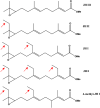Rational design of Lepidoptera-specific insecticidal inhibitors targeting farnesyl diphosphate synthase, a key enzyme of the juvenile hormone biosynthetic pathway
- PMID: 33746541
- PMCID: PMC7953025
- DOI: 10.1584/jpestics.D20-078
Rational design of Lepidoptera-specific insecticidal inhibitors targeting farnesyl diphosphate synthase, a key enzyme of the juvenile hormone biosynthetic pathway
Abstract
Reducing the use of broad-spectrum insecticides is one of the many challenges currently faced by insect pest management practitioners. For this reason, efforts are being made to develop environmentally benign pest-control products through bio-rational approaches that aim at disrupting physiological processes unique to specific groups of pests. Perturbation of hormonal regulation of insect development and reproduction is one such strategy. It has long been hypothesized that some enzymes in the juvenile hormone biosynthetic pathway of moths, butterflies and caterpillars (order Lepidoptera) display unique structural features that could be targeted for the development of Lepidoptera-specific insecticides, a promising avenue given the numerous agricultural and forest pests belonging to this order. Farnesyl diphosphate synthase, FPPS, is one such enzyme, with recent work suggesting that it has structural characteristics that may enable its selective inhibition. This review synthesizes current knowledge on FPPS and summarizes recent advances in its use as a target for insecticide development.
Keywords: Lepidoptera; bisphosphonate; enzyme inhibitors; farnesyl diphosphate synthase; juvenile hormone; short-chain isoprenyl diphosphate synthases.
© Pesticide Science Society of Japan 2021. This is an open access article distributed under the Creative Commons Attribution-NonCommercial-NoDerivatives 4.0 International (CC BY-NC-ND 4.0) License (https://creativecommons.org/licenses/by-nc-nd/4.0/).
Figures






Similar articles
-
Structural characterization of a lepidopteran type-II farnesyl diphosphate synthase from the spruce budworm, Choristoneura fumiferana: Implications for inhibitor design.Insect Biochem Mol Biol. 2018 Jan;92:84-92. doi: 10.1016/j.ibmb.2017.11.011. Epub 2017 Nov 26. Insect Biochem Mol Biol. 2018. PMID: 29183817
-
In silico identification of potential phytochemical inhibitors targeting farnesyl diphosphate synthase of cotton bollworm (Helicoverpa armigera).J Biomol Struct Dyn. 2023 Mar;41(5):1978-1987. doi: 10.1080/07391102.2022.2025904. Epub 2022 Jan 17. J Biomol Struct Dyn. 2023. PMID: 35037838
-
Characterization and tissue-specific expression of two lepidopteran farnesyl diphosphate synthase homologs: implications for the biosynthesis of ethyl-substituted juvenile hormones.Proteins. 2006 Nov 15;65(3):742-58. doi: 10.1002/prot.21057. Proteins. 2006. PMID: 16972283
-
Approaches for Designing new Potent Inhibitors of Farnesyl Pyrophosphate Synthase.Expert Opin Drug Discov. 2016;11(3):307-20. doi: 10.1517/17460441.2016.1143814. Epub 2016 Feb 15. Expert Opin Drug Discov. 2016. PMID: 26781029 Review.
-
Phosphonate and Bisphosphonate Inhibitors of Farnesyl Pyrophosphate Synthases: A Structure-Guided Perspective.Front Chem. 2021 Jan 6;8:612728. doi: 10.3389/fchem.2020.612728. eCollection 2020. Front Chem. 2021. PMID: 33490038 Free PMC article. Review.
Cited by
-
The genome and sex-dependent responses to temperature in the common yellow butterfly, Eurema hecabe.BMC Biol. 2023 Sep 25;21(1):200. doi: 10.1186/s12915-023-01703-1. BMC Biol. 2023. PMID: 37749565 Free PMC article.
-
Knockdown of farnesyl pyrophosphate synthetase gene TuFPPS by RNAi extends quiescent period and halts molting of the spider mite, Tetranychus urticae.Exp Appl Acarol. 2025 May 26;95(1):4. doi: 10.1007/s10493-025-01031-9. Exp Appl Acarol. 2025. PMID: 40418354
-
New ways and new hopes for IGR development.J Pestic Sci. 2021 Feb 20;46(1):3-6. doi: 10.1584/jpestics.M21-03. J Pestic Sci. 2021. PMID: 33746540 Free PMC article.
References
-
- C. M. Williams: Third-generation pesticides. Sci. Am. 217, 13–17 (1967). - PubMed
-
- M. Jindra, S. R. Palli and L. M. Riddiford: The juvenile hormone signaling pathway in insect development. Annu. Rev. Entomol. 58, 181–204 (2013). - PubMed
-
- V. Smykal, T. Daimon, T. Kayukawa, K. Takaki, T. Shinoda and M. Jindra: Importance of juvenile hormone signaling arises with competence of insect larvae to metamorphose. Dev. Biol. 390, 221–230 (2014). - PubMed
-
- M. Cusson and S. R. Palli: Can juvenile hormone research help rejuvenate integrated pest management? Can. Entomol. 132, 263–280 (2000).
-
- W. G. Goodman and M. Cusson: The juvenile hormones. In “Insect Endocrinology,” ed. by L.I. Gilbert, Elsevier, London, pp. 310–365, 2012.
LinkOut - more resources
Full Text Sources
Other Literature Sources

